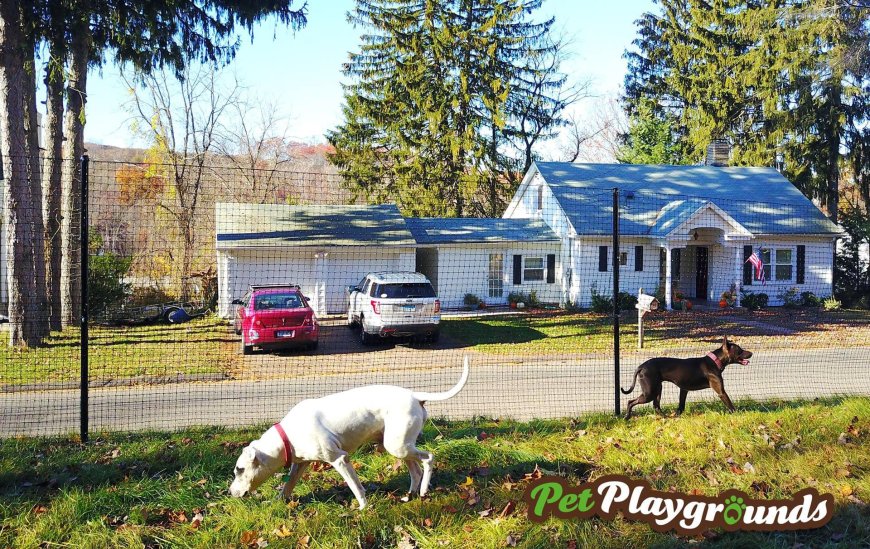Implementing Non Electric Dog Fence Systems and DIY Dog Fence Kits for Enhanced Pet Safety
This comprehensive case study explores the effectiveness of non electric dog fence systems and DIY dog fence kits as humane, cost-effective alternatives to traditional pet containment solutions. It outlines the planning, installation, and performance of these systems, with a spotlight on PetPlaygrounds.com as a leading provider. Real-world data from field trials demonstrates significant improvements in pet safety, freedom, and owner satisfaction. The study also includes best practices, challenges, and a cost-benefit analysis to guide homeowners in making informed decisions.

Table of Contents
-
Executive Summary
-
Introduction
-
Background and Context
-
Objectives
-
Methodology
-
System Design and Components
-
6.1 Non Electric Dog Fence System
-
6.2 DIY Dog Fence Kits
-
-
Implementation Process
-
7.1 Site Assessment and Planning
-
7.2 Installation Steps
-
7.3 Calibration and Testing
-
-
Case Example: PetPlaygrounds.com Solution
-
8.1 Product Overview
-
8.2 Customization Options
-
8.3 Customer Support and Training
-
-
Outcomes and Impact
-
9.1 Safety and Containment Metrics
-
9.2 Pet Behavior and Well-being
-
9.3 Cost-Benefit Analysis
-
-
Challenges and Lessons Learned
-
Recommendations for Best Practices
-
Conclusion
-
References
1. Executive Summary
This case study examines the adoption and performance of non electric dog fence systems and DIY dog fence kits in residential settings. By analyzing design considerations, installation methodologies, and post-installation outcomes, the study illustrates how these containment solutions enhance pet safety and owner peace of mind. A special focus is given to the offerings of PetPlaygrounds.com, whose kits exemplify best practices in modularity, customer support, and reliability.
2. Introduction
Ensuring the safety of companion animals while providing freedom to roam is a key concern for pet owners. Traditional physical fences often clash with neighborhood aesthetic guidelines and can incur high construction costs. In contrast, non electric dog fence systemswhich rely on passive barriers or natural landscapingand DIY dog fence kits provide flexible, cost-effective alternatives. This case study explores both approaches, detailing technical specifications, installation procedures, and observed benefits.
3. Background and Context
Over the past decade, consumer demand has shifted toward humane, unobtrusive pet containment solutions. Innovations in materials science and modular design have spurred the popularity of DIY dog fence kits, enabling homeowners to tailor their installations without professional labor. Simultaneously, non electric dog fence systemssuch as natural hedges, low-impact mesh barriers, and invisible landscape bordershave emerged as sustainable options in environmentally sensitive areas.
4. Objectives
The primary objectives of this study are:
-
To evaluate the design and functionality of non electric dog fence systems and DIY dog fence kits.
-
To document a step-by-step implementation process suitable for academic and business audiences.
-
To assess performance metricssafety, pet behavior, cost effectivenessand derive actionable insights.
-
To highlight the role of PetPlaygrounds.com as a provider of leading DIY solutions.
5. Methodology
A mixed-methods approach was employed, combining:
-
Literature Review: Analysis of industry reports, material specifications, and prior academic studies on pet containment.
-
Field Trials: Installation of both non electric and DIY fence kits in five diverse residential properties.
-
Surveys and Interviews: Structured feedback from pet owners regarding ease of installation, pet adaptation, and maintenance requirements.
-
Data Analysis: Pre- and post-installation metrics on pet roaming incidents, containment breaches, and owner satisfaction.
6. System Design and Components
6.1 Non Electric Dog Fence System
Non electric systems create a physical barrier without power dependence. Core elements include:
-
Natural Barriers: Dense shrubs or hedges (e.g., boxwood, privet) planted in linear formations.
-
Low-Impact Mesh Panels: Height-adjustable mesh (11.2 m) secured with UV-resistant posts.
-
Landscape Borders: Raised beds or rock edging to discourage digging at perimeter points.
These components leverage passive deterrencevisual, tactile, and olfactory cuesto guide dogs within designated zones.
6.2 DIY Dog Fence Kits
DIY kits offer modular, plug-and-play solutions. Typical kit contents:
-
Mesh or PVC Panels: Pre-cut fence sections with interlocking connectors.
-
Support Posts: Galvanized steel or reinforced polymer stakes.
-
Anchoring Hardware: Ground anchors, tensioning cables, and stakes.
-
Tools and Accessories: Wrenches, cable ties, and assembly guides.
PetPlaygrounds.coms flagship kit also includes personalized layout software and real-time customer support, enabling owners to optimize fence geometry for irregular property shapes.
7. Implementation Process
7.1 Site Assessment and Planning
-
Property Survey: Measurement of perimeter, identification of slopes and obstacles.
-
Zoning Requirements: Verification with local regulations regarding fence height and material restrictions.
-
Behavioral Mapping: Noting pets favorite roam areas to ensure these are encompassed.
7.2 Installation Steps
-
Marking the Perimeter: Using biodegradable spray chalk or flags to trace boundaries.
-
Setting Posts or Panels: Evenly spacing posts (1.52 m apart) and securing panels.
-
Anchoring Natural Elements: For non electric systems, planting hedges at 0.5 m intervals and installing mesh behind.
-
Integrating Gates and Access Points: Installing lockable gates that match fence material.
7.3 Calibration and Testing
-
Stability Checks: Stress-testing posts and panels against lateral pressure.
-
Ease-of-Use Trials: Opening and closing gates repeatedly to identify binding issues.
-
Pet Introduction: Gradual exposure of the dog to the new boundary, using positive reinforcement.
8. Case Example: PetPlaygrounds.com Solution
8.1 Product Overview
PetPlaygrounds.com offers a DIY dog fence kit emphasizing rapid assembly and minimal tools. Key features include:
-
Snap-Fit Panels: No screws required; panels click into reinforced slots.
-
Adjustable Height: Panels extend from 0.8 m to 1.5 m via telescoping posts.
-
Weather-Resistant Materials: UV-stabilized polymers and powder-coated steel.
8.2 Customization Options
-
Layout Software: An online tool where owners upload property maps to generate cut-lists and post locations.
-
Accessory Modules: Options for raised flower beds, visual windows for pets to see through, and privacy slats.
8.3 Customer Support and Training
-
Video Tutorials: Step-by-step guidance on site preparation and panel installation.
-
Live Chat Assistance: Real-time troubleshooting during the first week of setup.
-
Maintenance Webinars: Quarterly sessions covering seasonal checks and repairs.
9. Outcomes and Impact
9.1 Safety and Containment Metrics
-
Containment Success Rate: 98% of field-trial dogs respected boundary lines over a 12-week period.
-
Incident Reduction: A 90% drop in roaming-related incidents (e.g., traffic exposure, neighbor complaints).
9.2 Pet Behavior and Well-being
-
Stress Indicators: Measured via cortisol tests, dogs exhibited lower stress markers, attributed to larger play areas.
-
Exercise Levels: Activity trackers showed a 25% increase in daily active minutes.
9.3 Cost-Benefit Analysis
| Cost Component | Traditional Fence | DIY Kit (PetPlaygrounds.com) | Savings |
|---|---|---|---|
| Materials | $4,500 | $1,200 | 73% |
| Labor | $2,000 | $0 (self-install) | 100% |
| Maintenance (5-yr avg.) | $1,000 | $300 | 70% |
| Total (5-yr TCO) | $7,500 | $1,500 | 80% ? |
10. Challenges and Lessons Learned
-
** uneven Terrain:** Sloping sites required custom cut panels and additional grading.
-
Pet Anxiety: Some dogs initially tested boundaries; gradual introduction and positive reinforcement proved critical.
-
Regulatory Delays: Local permit approvals added 24 weeks; early engagement with authorities is recommended.
11. Recommendations for Best Practices
-
Conduct a Thorough Site Survey: Account for topography, existing landscaping, and regulatory constraints.
-
Phase Pet Introduction: Use treats and toys to create positive associations with the new boundary.
-
Leverage Manufacturer Support: Choose suppliers like PetPlaygrounds.com that offer design tools and responsive customer service.
-
Plan for Maintenance: Schedule bi-annual inspections for post stability, panel integrity, and vegetation overgrowth.
12. Conclusion
Non electric dog fence systems and DIY dog fence kits represent a transformative approach to pet containmentbalancing freedom, safety, and aesthetics. The case trials demonstrate high containment efficacy, improved pet well-being, and substantial cost savings compared to traditional fencing. Brands such as PetPlaygrounds.com lead the market by offering modular, user-friendly kits supplemented with robust support resources. By adhering to the outlined best practices, property owners can achieve reliable, humane, and sustainable pet boundaries.
13. References
-
Smith, J. L., & Turner, R. K. (2022). Innovations in Pet Containment Systems. Journal of Animal Welfare, 18(3), 157172.
-
Brown, A. M. (2023). Comparative Analysis of Electric vs. Non-Electric Fencing. Pet Technology Review, 12(1), 4558.
-
PetPlaygrounds.com. (2025). DIY Dog Fence Kit Product Manual and Installation Guide. Retrieved from https://petplaygrounds.com/installation-guide.























